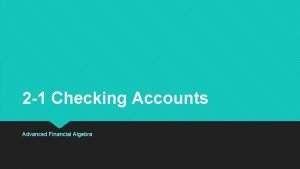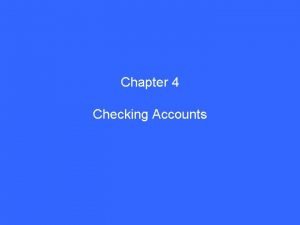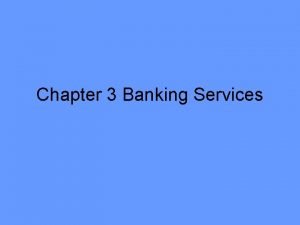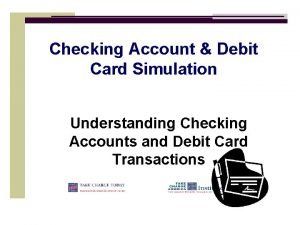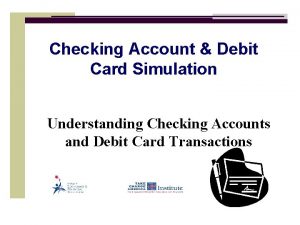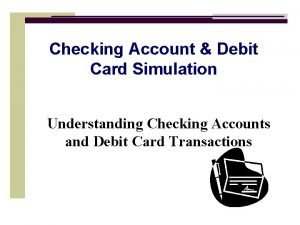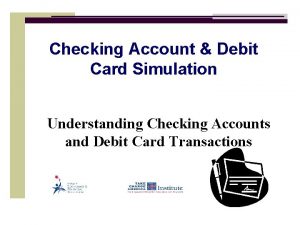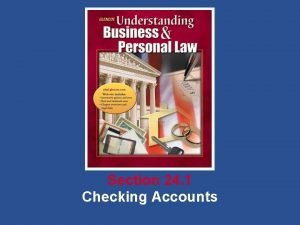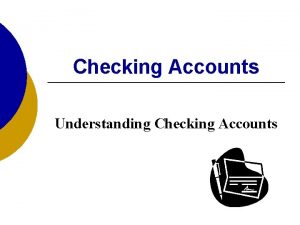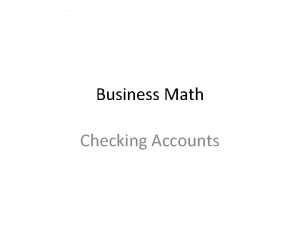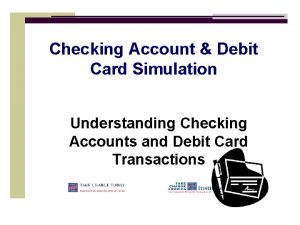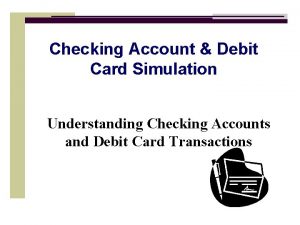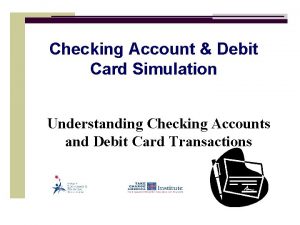Checking accounts chapter 23 section 2 Understanding checking











- Slides: 11

Checking accounts chapter 23 section 2

Understanding checking accounts • Checking accounts are one of the most commonly used banking service. • Checking accounts have to main advantages: Safety & Convenience. • It is best to put your money in checking accounts because it is a lot safer then keeping large amounts of cash at home. • Another type of checking account is an interest-bearing account called a negotiable order of withdrawal account.

Types of Checking Accounts • Banks usually offer a variety of checking accounts. • As long as the minimum balance is in the account there will be no extra charge. • A second type of checking account is the special account , often called a cost per. Check account, With this account you pay a flat monthly service charge. • Another type of checking account is interestbearing account called a negotiable order of

Opening a Checking Account • Once you have decided on a bank and checking account, opening an account is very simple. • You will have to fill out a form known as a signature card. • The signature card asks for your info such as address , phone number , Social security number, and similar data.

Writing a Check • A blank check requires 5 kinds of info. • Date-Record date on the check. • Payee-the person or institution that you write it to. • Numerical amount-The amount of the check in 2 places. • Written amount-Ten and 50/100 • Account number-acct#4738 -01 -796

Keepin a Check Register • After you open an account, you will receive a supply of imprinted checks and check register. • The register is where you keep a record of checks written , deposits made , and other transactions.

Endorsing a Check • An endorsement is your signature , sometimes with a brief message , on the back/left side of a check. • You must endorse a check before you cash or deposit it. • There are 3 different types of endorsements: blank , restrictive , and full.

Making a Deposit • The process of putting money into a checking account is known as making a deposit. • To do this you fill out the preprinted deposit ticket is used to deposit any combination of currency , coins , and checks. • You can receive a portion of the deposit

Balancing a Statement • Once a month , the bank will send you a packet that includes a statement of account and the cancelled checks that you wrote.

Checkpoint 1. What are 2 main advantages of having a checking account? 2. Explain the basic difference between a regular checking account and a special checking account. 3. Name the 5 kinds of information you must write on a check.

Checkpoint Continued 4. What is a mistake people often make with their check registers ? How can this mistake be prevented? 5. How should you endorse a check if your name is misspelled on the face of a check? 6. In simple terms , what is the purpose of balancing a checkbook?
 Financial algebra 2-1 checking accounts answers
Financial algebra 2-1 checking accounts answers 3-2 reconcile a bank statement worksheet answers
3-2 reconcile a bank statement worksheet answers Promissory note
Promissory note Check register reconciliation 3-4
Check register reconciliation 3-4 Checking account simulation
Checking account simulation 3 1 checking accounts worksheet answers
3 1 checking accounts worksheet answers 3-1 checking accounts worksheet answers
3-1 checking accounts worksheet answers 2-1 checking accounts answers
2-1 checking accounts answers 3 1 checking accounts answers
3 1 checking accounts answers Challenge 5 a use a checking account
Challenge 5 a use a checking account Balance zoe's bucks
Balance zoe's bucks Starting check number 101
Starting check number 101
